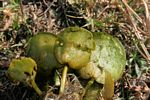Note 12: Amazon frogbit new to Africa by Mark Hyde
The aquatic species, Limnobium laevigatum, the Amazon frogbit, is recorded from Lake Chivero and this appears to be the first record for Africa.
On Sunday, 19th July, 2009, the Tree Society of Zimbabwe had an outing to Jacana Yacht Club on the shores of Lake Chivero.
In the afternoon, I led the party down to the edge of the lake. There was Eichhornia crassipes (en masse), Pistia stratiotes (a very few plants), Hydrocotyle ranunculoides, Myriophyllum aquaticum and an unknown aquatic plant.
We had seen this unknown aquatic in (white) flower on an earlier visit to Jacana and the object was to re-find, photograph and collect it. In fact, specimens were quite easily found, although there were no flowers or fruits at this time.
The extraordinary thing about the species, which immediately separates it from the other larger aquatic plants, is the thick air-filled underside of the leaf. This feature is a bit like certain species of duckweed but of course the leaves are much larger.
A temporary web page showing photographs of the plant was set up and advice was sought from various people. Bart Wursten identified as Limnobium laevigatum and that name has been confirmed by Prof. Dr J.J. Symoens of the National Botanic Garden of Belgium, who is a specialist in the Hydrocharitaceae and wrote the account of that family in Flora Zambesiaca 12(2).
I have searched in SRGH and there are no specimens of any species of Limnobium there; it would therefore seem to be a new record for Zimbabwe. Furthermore, according to Dr Symoens, it has not been recorded for Africa before and therefore appears to be a new record for Africa. Lesley Henderson (pers. comm.) tells me that there are no records for S Africa.
The native habitat of L. laevigatum is Central and South America. However, from numerous sites on the internet, it appears to be widely cultivated and sold as an aquarium plant. It is classified by the California Department of Food and Agriculture as a Noxious Weed List Q: Temporarily classified for treatment as A-rated (control action required), but more information needed (ref. 1).
We may speculate that the plant is being distributed by the horticultural trade and has the potential to become naturalised in wild habitats. The population at Lake Chivero was quite small in number; at the site, the most frequent aquatics were the Eichhornia, Hydrocotyle and Myriophyllum mentioned earlier; the Pistia and Limnobium were the least frequent.
I am most grateful to all those who assisted in providing information about this plant, namely Shirley Graham, Lesley Henderson, Jonathan Timberlake and Dr Symoens.
Mark HydeReferences:
1. http://www.calflora.org/cgi-bin/species_query.cgi?where-calrecnum=8599




